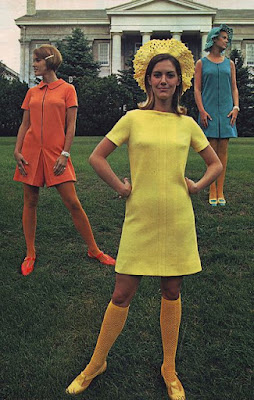Introduction
Fashion is more than just clothing; it's a reflection of our society, culture, and values. Over the years, fashion has evolved in tandem with the shifting sands of society, responding to political, social, and technological changes. In this article, we'll embark on a journey through the decades, exploring how fashion has transformed from the 1960s to the present day.
The 1960s: The Era of Revolution
The 1960s was a time of profound social and cultural upheaval. The counterculture movement, with its emphasis on peace, love, and individualism, left an indelible mark on fashion. The rise of "hippie" fashion was one of the defining trends of the era. It was all about natural fabrics, flowing silhouettes, and psychedelic patterns. Iconic events like Woodstock became synonymous with the free-spirited fashion of the '60s.
The political and social changes of the decade also influenced fashion. Women's liberation was in full swing, and fashion reflected this newfound empowerment. Miniskirts and bold, colorful prints took center stage. Meanwhile, across the pond, mod fashion and the British Invasion brought a fresh, youth-oriented approach to style. Key designers like Mary Quant and Andre Courreges pushed the boundaries of traditional fashion.
The 1970s: Disco Fever and Bohemian Vibes
The 1970s saw the emergence of disco culture, and fashion followed suit. It was an era of glitter, glam, and Studio 54. Disco fashion was all about sequins, flared pants, and platform shoes. It was a celebration of hedonism and excess.
But the counterculture spirit didn't die out entirely. Bohemian chic, influenced by the festivals and music of the era, continued to thrive. Flowing maxi dresses, fringe vests, and tie-dye prints were the hallmarks of this free-spirited style. Simultaneously, punk fashion emerged as a rebellion against the mainstream. Safety pins, leather, and DIY aesthetics defined the punk look.
The 1980s: Excess and Individualism
The 1980s were a time of excess and individualism. It was the era of consumerism, and fashion reflected this with power suits and "Yuppie" fashion. Bold shoulder pads, bright colors, and oversized accessories became the norm. Pop culture icons like Madonna epitomized the glamorous, daring style of the decade.
Technological advancements also played a significant role in fashion. The rise of sportswear and fitness fashion was a testament to the growing fitness craze. Punk fashion, which had its roots in the 1970s, transformed into new wave fashion, characterized by asymmetrical cuts and unconventional materials.
The 1990s: Grunge, Minimalism, and Globalization
The 1990s ushered in a new era of fashion diversity. Grunge fashion, heavily influenced by the music of bands like Nirvana and Pearl Jam, embodied anti-establishment aesthetics. It was a stark departure from the glamour of the '80s, with flannel shirts, ripped jeans, and a "just rolled out of bed" look.
On the opposite end of the spectrum, minimalism gained prominence as a response to the excess of previous decades. Designers like Calvin Klein championed clean lines, neutral colors, and simplicity. Streetwear and urban fashion also emerged, blending elements of hip-hop culture with a casual, sporty aesthetic.
The '90s were also marked by globalization and multiculturalism in fashion. Hip-hop and rap culture had a significant influence, from baggy pants to oversized jackets. The "supermodel era" took center stage, with names like Cindy Crawford and Naomi Campbell dominating the fashion world.
The 2000s brought about a digital revolution that transformed the fashion landscape. E-commerce and online shopping became increasingly popular, altering the way people accessed and purchased clothing. Celebrity fashion took on a new dimension as social media platforms like Instagram and Twitter allowed stars to directly influence style trends.
Nostalgia played a pivotal role in the 2000s, with fashion reviving elements from the '70s and '80s. Emo and punk made a comeback, with black eyeliner and band T-shirts resurfacing in mainstream fashion.
Yet, amidst the technological boom and nostalgia, sustainability and ethical fashion movements began to gain traction. People became increasingly aware of environmental and labor issues in the fashion industry. As a result, sustainable fashion brands emerged, offering eco-conscious alternatives.
The 2010s and Beyond: Sustainability and Individual Expression
The 2010s continued to witness the growth of sustainability as a dominant theme in fashion. Slow fashion gained momentum, advocating for well-made, timeless pieces over fast fashion's disposable culture. Secondhand and vintage fashion experienced a resurgence as people sought out unique, sustainable options.
Diversity and inclusivity became a driving force in the fashion industry. There was a growing emphasis on representing different body types and cultures. Gender-neutral and non-binary fashion gained recognition, breaking down traditional gender norms and expanding the possibilities of self-expression.
Technology remained a potent force, with virtual fashion shows and digital influencers changing the way fashion was presented and consumed. Customization and personalization trends allowed individuals to express their unique style.
As we look to the future, fashion is poised for even more transformation. Predictions include a continued focus on sustainability, a greater embrace of technology, and a deeper commitment to diversity and inclusivity.
Conclusion
Fashion is a dynamic mirror of society, reflecting the values, attitudes, and innovations of each era. From the flower power of the '60s to the high-tech chic of today, fashion has evolved in response to the ever-changing world around it. Understanding this evolution helps us appreciate not only the clothes we wear but also the cultural and societal shifts that shape our world. As we move forward, fashion will undoubtedly continue to evolve, serving as both a reflection of our times and an inspiration for the future.
Also Read: Beyond the Logo : From Runway to Real Life20 Frequently Asked Questions About the Fashion Industry: Insights and Answers.











No comments:
Post a Comment